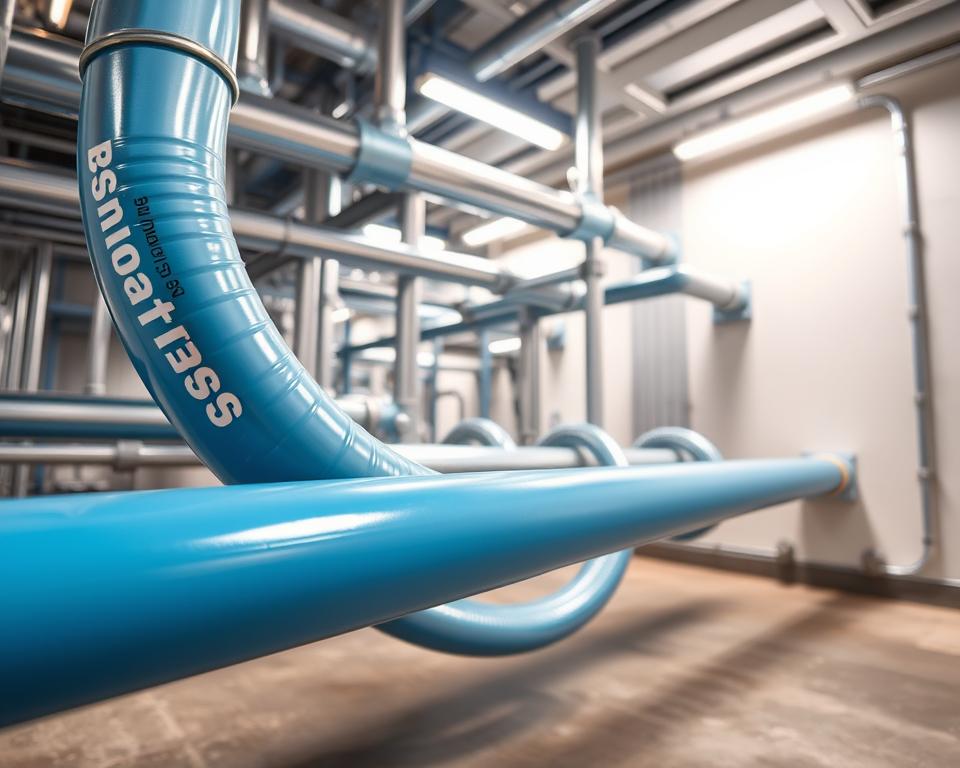PVC Pipe for Air Compressor Lines: Your Complete Guide
Did you know that a ruptured compressed air system can release energy equivalent to a stick of dynamite? Despite the hazards, numerous workshops continue installing piping systems from unsafe materials. Here’s why you must prioritize safety over cost when selecting PVC air line.
Although some plastics gain popularity, OSHA flatly forbids their above-ground application. Repeated contact with compressor oil and thermal cycling makes them brittle, causing explosive failures. Safe-rated pressures can still result in deadly bursts.
For reliable alternatives, Installation Parts Supply offers durable solutions like aluminum. Spending on the right materials prevents OSHA penalties and protects employees. Let’s explore how to build a safer system.

Fundamental Learnings
- OSHA bans certain materials due to explosion risks.
- Heat and cold swings slashes claimed pressure capacity.
- Long-term exposure makes pipes prone to brittle breaks.
- Aluminum piping offers a safer alternative.
- Spending on correct materials avoids penalties and injuries.
Why PVC Pipe Is Dangerous for Compressed Air Systems
PVC makers caution never to employ it in high-pressure air setups. Compressed air carries destructive energy; a burst is like a dynamite blast. Material selection is the linchpin of air-system safety.
- Brittleness: Cold snaps make pipe walls brittle and prone to cracking.
- Adhesive failures: Joints weaken when exposed to compressor oils or temperature swings.
- Misleading ratings: Pressure capacity drops 50% at 110°F—most workshops exceed this.
After a PVC burst hurt staff, OSHA levied a $110,000 fine. The “heat of compression” further reduces safe operating limits, a factor often overlooked in ratings.
“Above-ground use of certain plastics for compressed air violates OSHA standards due to explosion risks.”
Steel and aluminum curve under stress instead of shattering. Fragments from PVC blasts can hurl past 50 feet, embedding dangerously.
Workshops face daily temperature fluctuations that accelerate material degradation. A decade’s UV and chemical attack weakens plastic, so small leaks too often balloon into disasters.
Safe Alternatives to PVC Pipe for Air Compressor Lines
Aluminum air lines deliver superior safety and leak reduction. Black pipe vs. aluminum: aluminum wins with 90% fewer leaks. Aluminum’s lightness and anti-rust traits prolong system life.
Snap-together modular aluminum cuts installation hours. Installation Parts Supply stocks ready-to-snap aluminum modules. A car plant saw a 40% drop in labor expenses after aluminum installation.
- Copper: Best for cleanrooms due to natural antimicrobial properties. Requires soldering expertise.
- Stainless Steel: In seaside shops, stainless steel won’t corrode.
- ABS/HDPE: Plastic choices like ABS or HDPE handle harsh chemicals.
“Our aluminum retrofit reduced energy waste by 15%—paying for itself in 18 months.”
Proper torque is critical. Too tight splits fittings; too loose lets air escape. Stick to recommended 25–30 ft-lb torque for aluminum.
NSF-approved lines keep food-grade air clean. Choose pipe rated for your specific operating environment.
Selecting the Best Air Compressor Piping
Consider cost, compliance, and efficiency in your pipe decision. A Midwest factory saved $12,000 annually by switching to leak-resistant aluminum. Here’s how to make the right choice.
| Material | Cost (per ft) | Maintenance | ROI Time |
|---|---|---|---|
| Aluminum | $8.50 | Low | 18 months |
| Black Pipe | $5.00 | High | N/A |
| Copper | $10.20 | Medium | 24 months |
Watch your operating temperatures. From arctic chills to high heat, aluminum outperforms. Use stainless steel where solvents are present.
Pro Tip: Calculate ROI using CFM loss formulas. A 10% air leak in 50 HP equals about $3,500 annually.
- Match PSI ratings to your compressor’s output.
- Keep records of inspections and tests to satisfy OSHA.
- Request a free system audit from Installation Parts Supply.
“Our aluminum retrofit cut energy waste by 15%—paying for itself in 18 months.”
DIY installations work for small shops, but professionals ensure leak-free joints. Don’t forget to read the fine print on warranty lengths.
Conclusion
Choosing the right materials for your compressed air setup isn’t just about cost—it’s about safety. Older systems account for 92% of accidents due to degraded piping. With 99.8% uptime, aluminum is the clear long-term choice.
Remember:
- Avoid brittle materials that shatter under pressure.
- Choose rust-proof metals over plastics.
- Failing to comply can cost you big in fines and claims.
Time to make the switch? Installation Parts Supply provides same-day quotes and limited-time discounts on starter kits. Request your free template or emergency service today.
Make safety your piping priority—act today.
